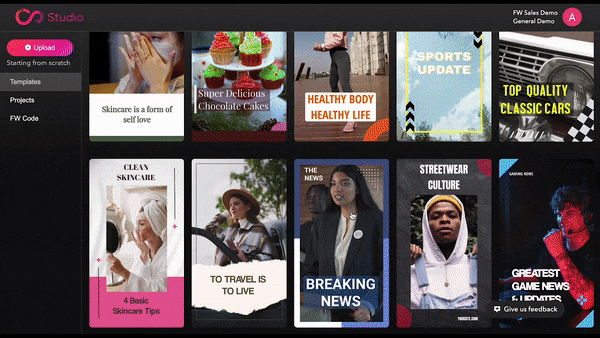According to a 2023 report by Wyzowl, 87% of all marketers agreed that video marketing had helped their brands increase sales. And while video ecommerce can be a very effective sales channel, not all brands and retailers are leveraging it as they should.
The experts at Firework reveal the top 5 rules that brands should follow in order to unlock the full potential of video commerce on their websites.
1. Choose the right shoppable video commerce platform
The very first, and most important step, in getting started on your video ecommerce journey is finding the right video commerce platform.
It may be tempting for brands to have an in-house team dealing with everything to do with video shopping. While this approach is fine for generating video content, taking on the burden of the technical aspects can be challenging even for the biggest brands and retailers. This is especially true for an ecommerce website that receives a high volume of traffic.
Partnering with a video commerce platform lets brands focus on what they do best: getting creative with their content strategies in order to drive sales. The video commerce platform can do all the technical heavy lifting required to turn those strategies into reality; not to mention the wealth of industry expertise that such a platform can bring to the table.
To unlock video shopping’s full potential, seek a platform that offers a solutions suite that combines livestream shopping and shoppable videos.
There is no dearth of tech providers that focus either on live shopping or shoppable videos. However, leveraging only one of these while ignoring the other is a massive missed opportunity.
Video commerce platforms like Firework help brands unlock the true potential of video ecommerce by leveraging both live and shoppable videos. This creates a truly complete video commerce solutions package that allows brands to tap into everything that video selling has to offer.
2. Create unique, engaging video content
After partnering up with the right video ecommerce platform, your brand is now free to create video content for its website that will convince consumers to make a purchase. This can often be much easier said than done.
When creating shoppable video content, it is not uncommon for brands to overlook the most important aspect of the video that makes it stand out as a format, i.e. how highly engaging it is!
The format is already doing most of the work for you, as proven by the success of short videos on social media platforms; the content should build on this to drive engagement with a captive audience. One proven and successful way to do this is by focusing on creating unique content for viewers.
Unique content doesn’t have to be something extreme that has never been seen before. It could be something as simple as how-to videos, product videos explaining key features, or user-generated content like reviews – any content that embodies the values and identity of your brand. Such a video will do justice to your brand as well as your customers, who will get helpful information they need before making a purchase.
Gen Z customers, a key target audience, seek authenticity above everything else in the content they consume, and this includes any live or shoppable video content they are subjected to. Keep this need for authentic content in mind when you create product videos.
Video content that puts your brand voice front and center will exude authenticity and uniqueness, thereby driving engagement with your consumer base.
3. Make call-to-actions clear and obvious
Attracting and engaging potential customers is great, but it amounts to nothing if those customers do not convert. After all, conversion is the ultimate goal of every customer journey.
Marketing video is one of the most effective marketing tools in helping reduce the consideration period between intent and purchase. But it is only effective when consumers are told, as clearly as possible, about the action they need to take.
Whatever the goal of your video commerce strategy or campaign is, the call-to-actions in the video content must reflect that. And they should do so in a manner that the consumer is driven to take the right action.
Want customers to add something to a cart? Don’t be shy to remind them often. Tempting customers to shop for more via discount codes unique to the livestream? Let them know about it as much as you can.
Firework solutions include a number of ways in which brands can make their CTAs obvious for an audience and easy for customers to execute. This includes Instant Checkout, which consumers can use to instantly buy a product with a few clicks, without leaving the video player.
A live or shoppable video that does not have the right CTAs will fail to benefit from the engagement that it is creating, no matter how great the content is.
4. Go vertical for mobile audiences
According to Comscore, by the 4th quarter of 2022, mobile commerce accounted for 38% of all digital spending in the United States. With this percentage continuing to rise, not to mention how much video is consumed on mobile devices, adopting a vertical content strategy just makes sense.
At a time when everything is optimized for mobile, not doing the same with live and shoppable videos counts as a massive oversight.
Younger generations – especially Gen Z – are used to consuming vertical video at scale, making it easier for brands to pass off shoppable vertical videos as native, without compromising immersiveness.
Creating the right kind of vertical content is quite different from the way videos usually are made, but there’s no reason why it has to be difficult. The surge in the number of social media platforms has also brought about a rise in the number of software and apps dedicated just to vertical video.
Firework partners get access to Firework’s Creation Studio – a tool that helps brands quickly create shoppable video content that is impactful and captivating, at scale.
 5. Measure and analyze your video marketing for ecommerce
5. Measure and analyze your video marketing for ecommerce
“Data, data, data! I can’t make bricks without clay.” Unlike the man who uttered these words, you don’t have to be a Victorian-era consulting detective to deduce that successful video shopping campaigns are built on a solid foundation of ample data.
While converting customers remains the primary goal of any livestream event or shoppable video carousel, the data collected regarding viewers and audience behavior can be equally invaluable.
From view durations, to interactions with the video player, to average order values, it all adds up to create a data pool, lessons from which can be used to optimize not only future video content and campaigns but also the overall marketing strategy.
At a time when data collection and privacy laws are putting the squeeze on platforms and marketers, first-party data is king. And brands that fail to continue measuring and analyzing this data run the risk of losing out to the competition and missing out on higher ROI.
The Takeaway
Video marketing is the next ecommerce frontier that will determine how well a brand can thrive as well as drive conversion rates in Web 3.0 surroundings.
As in many situations, getting the first step right is critical for brands. If your brand partners with the right video ecommerce platform, all the other things on the list fall into place perfectly.
FAQs
Whether it's your first time using videos as a part of your ecommerce marketing strategy, or your seventeenth, here are some frequently asked questions about the process.
Why is video important to ecommerce? 
Video can be essential to helping prospective customers better understand a product’s features. Unlike brick-and-mortar stores, customers cannot physically touch and examine products when purchasing online. Videos help customers not only get a more realistic look at the product but also gives them additional insights. Videos have a proven track record in increasing conversions, sales, and customer satisfaction.
Why should my brand use ecommerce videos? 
Most people today prefer watching ecommerce product videos than reading long product descriptions. Ecommerce video content makes a website viewed by a larger audiences, increases page visits, and increases the chance of conversions. Video e-commerce content is also useful to be shared with the media.
How does video affect the customer journey? 
Ecommerce videos are an efficient way to attract people’s attention during the awareness phase of the journey. Different types of video content determines which direction your customer’s journey will take. At every step of the journey, personalize the video content as much as possible to meet customer expectations.






 5. Measure and analyze your video marketing for ecommerce
5. Measure and analyze your video marketing for ecommerce





